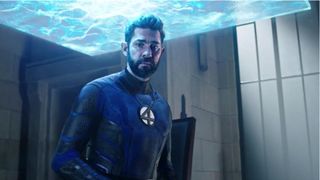Saying goodbye to Marvel Phase 4 – the MCU’s weirdest, wildest, and most inconsistent Phase yet
Celebrating the hits (and misses) of Marvel's post-Endgame era

How do you follow one of the most successful movies of all time and continue a story that has a perfect ending? That was the unenviable task facing down Marvel’s Phase 4.
In the wake of Avengers: Endgame, the Marvel Cinematic Universe was in limbo. With Robert Downey Jr.’s Iron Man and Chris Evans’ Captain America having perished, the MCU lost two of its most marketable heroes. In their place, a bunch of unknowns: The Eternals, Ms. Marvel, Moon Knight, and Shang-Chi. To bolster the ranks, movies and shows about characters few thought needed their time in the spotlight. Far from being a billion-dollar guarantees, Marvel Studios’ output felt uncertain for the first time in over a decade.
Over the next three years, Kevin Feige and his team of producers, creatives, filmmakers, and actors shepherded in a new era of the MCU – featuring some of the series’ most creatively ambitious, progressive, and varied storytelling yet. It also stands as one of its least successful eras, both commercially and critically. However, something almost all critics can agree on, WandaVision kicked off Phase 4 with style in January 2021.
A bewitching start

Marvel Phase 4 can best be characterized in one word: experimental. Nothing better encapsulated that idea than WandaVision. Part-parody of classic television sitcoms (including The Dick Van Dyke Show, Bewitched and Malcolm in the Middle) and part-mind-bending character study of Wanda coming to terms with the loss of her beloved Vision, it set an impossible bar that was never quite matched.
It did, however, usher in some unorthodox expectations. Instead of larger-than-life superheroes doing battle on green screen-heavy landscapes, Marvel frequently approached things differently. That allowed the likes of Moon Knight – a quieter exploration on mental health – and the meta-heavy She-Hulk to thrive. Those more 'out there' projects may have only arrived in fits and spurts – CGI still wins out in the end, after all – but they also laid the foundations for Marvel to look more outwards in its representation.
Phase 4 continued that fresh approach as many of its big hitters took a back seat in favor of new, exciting, and (crucially) underrepresented heroes.
It has been a sustained period of firsts: Chinese and Pakistani heroes in Shang-Chi and Ms. Marvel finally got their chance to shine in what had been, up until now, a pretty homogenous lineup. Phase 4 also saw the emergence of the first solo female director in the MCU as Cate Shortland helmed Black Widow, plus Letitia Wright’s Shuri became the franchise’s first Black female lead in Wakanda Forever. LGBTQ representation has also improved with Eternals’ Phastos, Thor’s Korg, Wakanda Forever’s Aneka, She-Hulk’s Nikki, and confirmation that Loki is bisexual. Some of these are the tiniest of baby steps – and things to build on for Phase 5 and 6 – but are welcome additions nonetheless.
Sign up for the Total Film Newsletter
Bringing all the latest movie news, features, and reviews to your inbox
The new Phase also heralded the start of the Disney Plus era. In the past, Marvel movies felt like massive events, exclusively consigned to the box office and (if you’re lucky) getting three MCU entries a year. Disney’s streaming service changed all that, meaning some years there were only weeks between new projects.
Sure, smaller scale stories were now able to be told in longform format and one-shot specials such as Werewolf by Night found a home on the streamer, but it undoubtedly led to the acceleration of Marvel fatigue. As the MCU reached critical mass, the scattershot approach to superheroes – also not helped by Phase 4’s seeming lack of overarching narrative – led to some notable disappointments. Black Widow and Eternals struggled, while the tightly-packed schedule of productions led to problems elsewhere. Rushed CGI has been a constant complaint since Endgame and the lack of time between projects – as evidenced by WandaVision and Multiverse of Madness filming back-to-back – meant plot threads were left dangling for far too long (will we ever see Hercules again?). In Wanda’s extreme case, that even amounted to what felt like two oscillating versions of the same character showing up just a year apart.
Cracking open the multiverse

Despite some stumbles, much of the Phase was still anchored by the safety net of its biggest names. Doctor Strange and Thor sequels were successes and Spider-Man: No Way Home not only became the highest grossing movie of the COVID era, it also unlocked the unlimited potential of the multiverse.
It was the concept of the multiverse, the idea that an infinite number of universes with slight variations existed, that allowed Marvel’s brave new world to thrive. No Way Home managed to slice through the thorny issue of previous Spider-Man universes, all while simultaneously tapping into the sudden ferocious demand for 2000s nostalgia.
Multiverse of Madness took that a step further, introducing John Krasinski’s Mister Fantastic and folding Patrick Stewart’s iconic Charles Xavier from Fox’s X-Men movies into the MCU. That playful energy also extended to Marvel Studios’ first animated project. What If…? arguably utilized the sandbox of the multiverse even more effectively than either the Spidey threequel or the Sam Raimi-helmed Doctor Strange 2 with its darker and bleaker takes on tried-and-tested Marvel touchstones. Only in Phase 4 could a show feature Ultron killing Thanos and almost destroying all of creation, then the next week introduce zombies.
The other half of the new Phase featured a brief hello to MCU’s newest Big Bad. Bursting with charisma and quiet menace, Jonathan Majors’ He Who Remains cameo at the end of Loki was a well-timed disruption to a relatively listless period for Marvel. His version of Kang will make a bigger splash in future MCU projects, and his initial arrival was a welcome one. However, it was indicative of the fact that, Thunderbolts teases aside, Marvel was really lacking an overarching direction for large parts of Phase 4. It felt like the sort of weird, fantastical kookiness that could only ever be embraced in a post-Endgame era that wasn’t afraid to trust that its audience would go along for the ride.
Which brings us to the end. Black Panther: Wakanda Forever was the final chapter of the first part of what is now known as The Multiverse Saga. What did the sequel to one of the MCU’s best movies have to tell us about what has been and what is to come? In truth, Wakanda Forever was its own thing, accentuated by unfortunate circumstances: a portrait of grief after the sad and sudden loss of Chadwick Boseman. In many ways, it’s Phase 4 through and through: it marched to the beat of its own drum and platformed new heroes and new voices in the process.
With multiple Avengers movies, Fantastic Four, and Kang all on the horizon, Phases 5 and 6 are expected to fall more in line with what came before. In that sense, Phase 4 is an anomaly – and one that deserves to be celebrated. It had its missteps and miscalculations, but it also had the weekly watercooler conversations of WandaVision, She-Hulk tearing a hole through the fourth wall, Simu Liu’s punchy debut as Shang-Chi, Wakanda Forever’s heart wrenching final scene, and so much more besides that. The MCU, now more than ever, is a broad church where Avengers can exist side by side with alligator Lokis and millenia-old humanoids. It has embraced the fun, sillier side of superheroes and blended it skilfully with more richly drawn and introspective pieces. Phase 4’s biggest failing was that it tried too much. That was also its biggest strength. Whatever your criticisms of the past few years, the MCU can no longer be accused of playing it safe.
Discover more of the upcoming Marvel movies with our guides to Marvel Phase 5 and Marvel Phase 6.
I'm the Senior Entertainment Writer here at 12DOVE, focusing on news, features, and interviews with some of the biggest names in film and TV. On-site, you'll find me marveling at Marvel and providing analysis and room temperature takes on the newest films, Star Wars and, of course, anime. Outside of GR, I love getting lost in a good 100-hour JRPG, Warzone, and kicking back on the (virtual) field with Football Manager. My work has also been featured in OPM, FourFourTwo, and Game Revolution.
Most Popular


